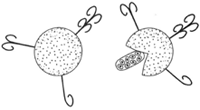Pathogenic Ascomycetes
Microsphaera alni is an ascomycete that infects the leaves of the common lilac. It produces conidiospores at the ends of hyphae by abstriction. Ascus production occurs in a completely enclosed fruiting body called a cleistocarp. The formation of asci is not associated with a fusion of gametic nuclei. When an infected lilac leaf is examined, the conspicuous element is the whitish mycelium with its powdery profusion of conidiospores. It is a powdery mildew. Careful examination with a lens discloses small, black dots; these are the cleistocarps. In figure 19-7 a cleistocarp having anchoring filaments has ruptured, and asci-bearing ascospores are being extruded. |
| Figure 19-7 Micmspbaera alni: at right, the cleistocatp has ruptured, releasing an ascus having eight ascospores. |
Endothecia purasitica is another ascomycetous plant pathogen. It has caused the near extinction of chestnut trees in the United States. The fungus was inadvertently brought to this country on stock brought from the Orient near the year 1900. From the initial point of infection in Long Island, New York, it spread throughout the country and destroyed nearly all the chestnut trees. Although a few resistant trees remain and a comeback is possible, its not yet much evident.
Ceratostomella ulmi causes Dutch Elm disease, so-called because it was first described in the Netherlands. This fungus infects the American Elm tree. The infection began in this country in 1930; again, the source was imported stock. It has spread widely and caused vast destruction among American Elm trees. The destiny of the American Elm appears to be the same as that of the American Chestnut.




